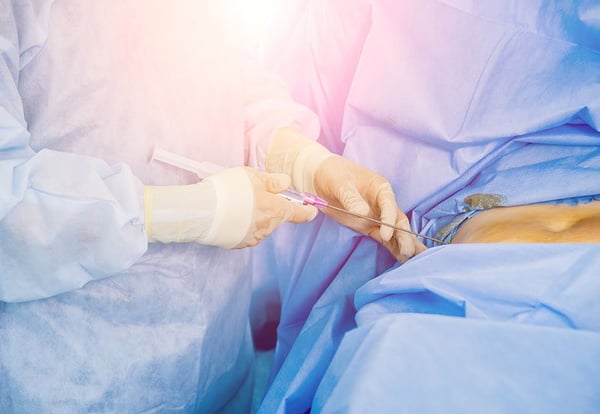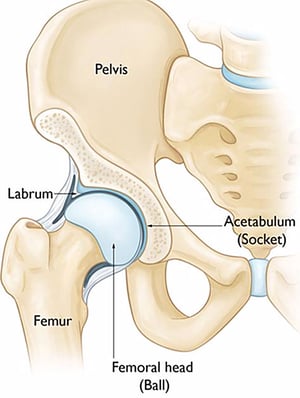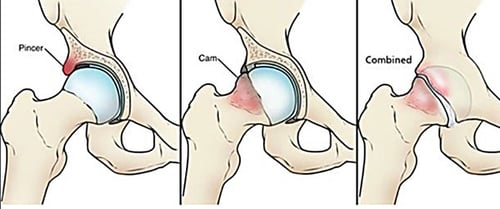Procedures
Hip Arthroscopic Surgery

Experiencing pain in the hip

Please seek medical help if you have any of these symptoms. Your orthopaedic surgeon will take a detailed medical history from you, perform a thorough medical examination and likely organise an MRI scan of your hip to confirm the labral tear.
FAI femoral acetabular impingement
The CAM type of FAI occurs due to an extra bump of bone at the junction of the femoral head and neck. This extra bone collides or impinges on the labrum when the hip is moved around. Imagine having a small stone in your shoe! The soft labrum is therefore squeezed between the bony acetabulum and bony bump and ends up tearing. If the bony bump is not removed and the labrum is not repaired, the hip will become arthritic sooner than later.
The pincer type of FAI occurs when there is overhanging or extra bone around the acetabulum. As the hip is moved, the pincer crushes the soft labrum against the hard femoral neck, resulting in a badly damaged labrum and painful hip. Some patients have a combined CAM and pincer which makes their symptoms worse.

Arthroscopic labral repair
Many years ago, repair of the labrum involved open surgery where a large skin incision was made. These days arthroscopic or keyhole surgery is performed for the same purpose. Small incisions allow wounds to heal faster, lower the risk of infection and reduces the collateral damage to other structures in the hip. Several incisions about 1 or 2cm long are made around your painful hip. The instruments used for this procedure are long and thin like chopsticks. It allows accurate localisation of the torn labrum and precise repair of the tear. Labral tears should also not be repaired in isolation. The offending CAM bony bump or overhanging pincer must be addressed to prevent repeat tears in future.
Rehabilitation after surgery may take 3 to 6 months. In the early days after surgery, medication is given to manage general pain around the hip, ice is applied to reduce swelling and patients are not allowed to bend their hips beyond 90 degrees to protect the repair site. While the arthroscopic scars are small and heal in 2 weeks, patients need to go for frequent physiotherapy after surgery to prevent scarring in their hips, maintain muscle strength in the thighs and promote smooth a walking pattern. Cycling on a stationary bicycle is important to get your hips going to prevent stiffness. Most patients return to brisk walking at about 3 months and sports at 6 months.
The intention of hip preservation surgery is to repair and patch up the hip injuries and delay the need for a formal hip replacement. There is a chance that damage in the hip is too advanced and patients continue to have pain despite hip preservation surgery. In these cases, we would counsel patients for a total hip replacement so that they may return to their active lifestyles again. It is not true that only elderly patients receive a total hip replacement and it is not true that you cannot be active after hip replacement surgery. Do speak to us if you have been bothered by your hip pain. We are equipped with a spectrum of non-surgical and surgical techniques to help you with your symptoms.
Is it alright to walk around with a sprained ankle?
This depends on the sprain's severity and what treatment has been rendered for the injury. Your doctor may advise you to only put minimal weight on your ankle while it is still recovering from the injury. Excessive walking may lead to more pain and swelling if the injury is stressed too early on.
How do I know if my ankle sprain is serious?
The nature of the initial accident or injury will provide a good idea about how fast it may recover. A serious injury is characterized by severe pain, swelling, and recurrent sprains despite efforts to support and treat it. If you are experiencing these, the soonest visit to the specialist is highly advised.
Can I claim insurance for my ankle injury?
Ankle sprains and injuries are insurance claimable. We do advise our patients to check with their personal or corporate insurance plans and representatives. We are also able to help them with this if required.
What should I do immediately after an ankle sprain while waiting for my appointment and treatment?
Timely self-care with rest, icing, compression, and elevation are important to manage the initial pain and swelling around the ankle. Anti-inflammatory medication will further reduce the pain and swelling that you may be experiencing.
I have more questions, how can I speak to a doctor?
Please call us at +65 6733 4565 (during office hours), or drop us a text or WhatsApp message at +65 9766 4565. We will reply to your queries as soon as we get them. You may also call to make an appointment to see Dr. Mizan for your ankle injury.